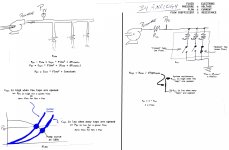So, I'm back at this stupid pump house again. Having the same conversation about starting up a second pump to maintain pressure. What it is, is a community cistern fed by a set of wells with two pumps in parallel pumping water out to the community system. Both pumps are driven by a VFD, but they are set up for redundancy, not to be ran in parallel.
The pump house floor and cistern bottom are on the same horizontal plane.
Now, when looking in to this, the conclusion I've came to is that it doesn't make sense to try and use the second pump to help maintain pressure, as the net gain doing this just isn't worth it. My thinking is this:
The pump wants to maintain a certain position on it's curve. The VFD is regulating the pump's rotational speed/angular velocity by using a pressure sensor for feedback. As far as the volumetric flow goes, the pipe diameter, fittings, etc are basically set.
So, when the pressure is dropping, it is because the velocity of the fluid in increasing, such as a fire hydrant opening or more people opening their taps.
But I am a bit lost from here. I'm not quite sure what happens when adding a second pump. Is it just introducing pressure into the system? I can't see it introducing pressure without also increasing the fluid velocity and losses.
Both pumps are on PI control, and I finally told the customer that I'm not an expert, but I don't think the juice is worth the squeeze and that I'm not the right person to tackle that job. I really don't think it will work, anyway but they won't accept that answer. The system was built back in the 60's and was originally an across-the-line starter.
Here are a couple pictures for reference:
https://i.imgur.com/Me1isJ9.jpg
https://i.imgur.com/Zhe6SO7.jpg
The pump house floor and cistern bottom are on the same horizontal plane.
Now, when looking in to this, the conclusion I've came to is that it doesn't make sense to try and use the second pump to help maintain pressure, as the net gain doing this just isn't worth it. My thinking is this:
The pump wants to maintain a certain position on it's curve. The VFD is regulating the pump's rotational speed/angular velocity by using a pressure sensor for feedback. As far as the volumetric flow goes, the pipe diameter, fittings, etc are basically set.
So, when the pressure is dropping, it is because the velocity of the fluid in increasing, such as a fire hydrant opening or more people opening their taps.
But I am a bit lost from here. I'm not quite sure what happens when adding a second pump. Is it just introducing pressure into the system? I can't see it introducing pressure without also increasing the fluid velocity and losses.
Both pumps are on PI control, and I finally told the customer that I'm not an expert, but I don't think the juice is worth the squeeze and that I'm not the right person to tackle that job. I really don't think it will work, anyway but they won't accept that answer. The system was built back in the 60's and was originally an across-the-line starter.
Here are a couple pictures for reference:
https://i.imgur.com/Me1isJ9.jpg
https://i.imgur.com/Zhe6SO7.jpg




